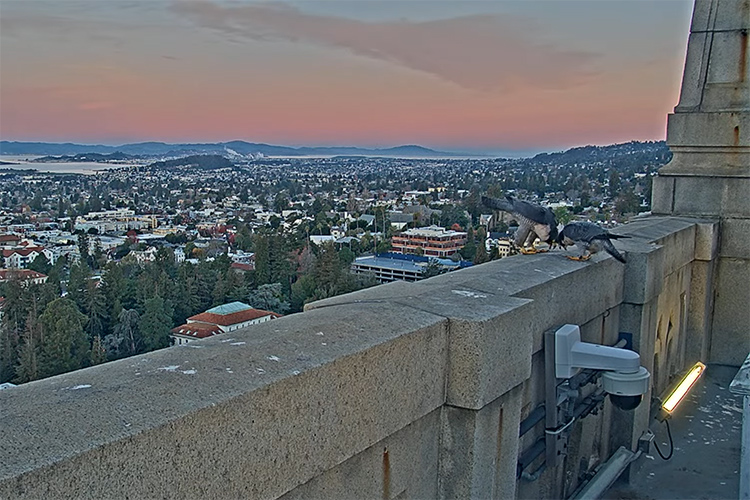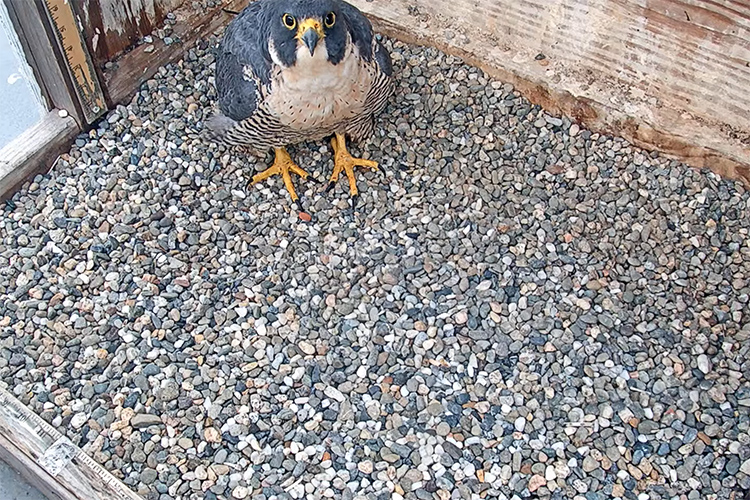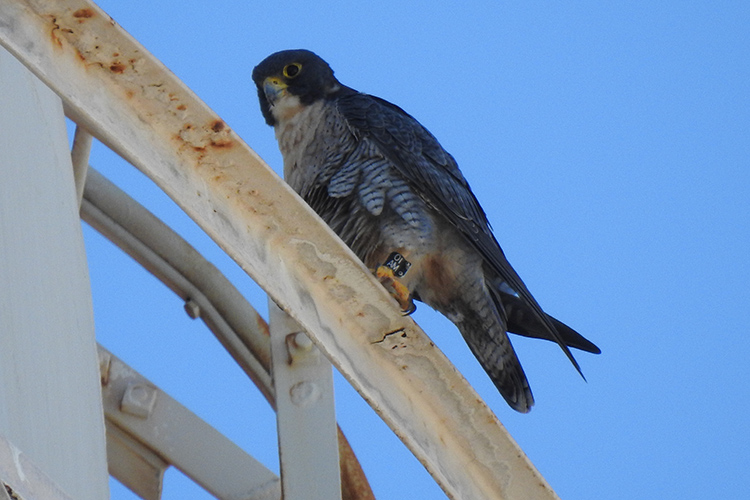Annie the falcon’s New Year’s resolution? Grinnell, not his rival
Longtime campus peregrine falcon couple Annie and Grinnell appear to have reunited following Grinnell's recent hospitalization, when Annie began eyeing the male falcon who had injured her mate.

January 3, 2022
On New Year’s Day, UC Berkeley’s longtime peregrine falcon pair, Annie and Grinnell, bid goodbye to 2021, but apparently not to each other, with courtship behavior observed for the first time since Grinnell returned to campus on Nov. 17 after being attacked by rival falcons in October.
One of the three webcams on the Campanile, where the raptors have produced 13 chicks since 2017, picked up the hopeful activity — head bowing on a ledge of the 307-foot-tall bell tower at about 7:30 a.m.
The raptors’ future as mates has been in doubt ever since Oct. 29, when Grinnell was found injured on a trash can in Berkeley and taken to Lindsay Wildlife Rehabilitation Hospital in Walnut Creek. While he was healing there, Annie began soliciting pairing behavior with the male falcon involved in Grinnell’s attack, and the two were seen flying and landing together on campus.
“The new male had begun to display similar courtship behaviors with Annie, … and they were actually courting pretty intensely for a little bit,” said Lynn Schofield, an ornithologist who is a member of Cal Falcons.
Generally, Annie and Grinnell’s annual bonding behavior begins in mid-January, with head bow displays and the preparation of their nest box on the tower. They begin to mate “in earnest right around Valentine’s Day, and egg-laying has been pretty consistently around March 10 to 15,” said ornithologist Sean Peterson, also on the Cal Falcons team.
But already yesterday, Jan. 2, Annie was seen mid-afternoon on the webcam at the nest site, indicating that “she’s in the breeding mindset right now,” said Schofield. Annie was “scraping” the nest, getting it ready by laying flat on her stomach and kicking the gravel to create a small depression.

Annie was seen on Sunday, Jan. 2, 2022, on the nest where she’s laid eggs since 2017, indicating her interest in breeding this winter. (Cal Falcons image)
Cal Falcons’ Mary Malec, who monitors local raptor nests for the East Bay Regional Park District and leads crews of volunteers who keep an eye on the Berkeley campus’s falcons, said Annie and Grinnell have been seen on the tower regularly, and on other structures west of campus, since Grinnell was released from the hospital.
“They know each other is around,” she said. “They have been talking to each other and flying together, but this is the first time anyone has seen courtship behavior between them. With the days getting longer, this is the time that courtship behavior starts to increase.”
Recently, Annie and Grinnell have been seen on the Campanile at dark, indicating that one or both of them sleeps on the tower’s outer ledges, said Malec. They don’t use the nest box except if there are eggs or chicks there, during the nesting period, she said, but they stay close to the nest to defend their territory.
Since Annie and Grinnell’s arrival on campus in late 2016, “floaters” — non-breeding adult birds of prey attracted to occupied territories — have frequently circled the Campanile looking for the opportunity to take the couple’s home away from them. In October, Grinnell was injured by a male and a female floater who chased him from his territory. But the male rival, who initially showed interest in Annie, “hasn’t been seen in a couple of weeks,” said Peterson.
Schofield said that Grinnell “appears to have healed wonderfully” after suffering a damaged upper beak, a wound near his chin and throat and an injured left wing.

Within hours of being released outside the Lawrence Hall of Science on Nov. 17 after being treated for injuries at Lindsay Wildlife Rehabilitation Hospital, Grinnell flew back to his home on the Campanile. (Photo by Bridget Ahern)
The broken tip of his bill is growing back, and observers on the ground on campus “have not been noticing any stiffness in his wings, like they were seeing immediately after his release,” she said. “You can still see that some of his flight feathers are broken, but for falcons, feathers are only replaced once a year, usually in the early fall, after breeding has been completed.”
Grinnell’s been seen hunting successfully and has displayed “a bulge on his throat, indicative of a crop full of food,” Schofield added.
Malec said Cal Falcons is grateful for the care that Grinnell received from Lindsay Wildlife Experience. “It was helpful that his injury and recovery happened outside of breeding season, so he had time to recover,” she said. “Hunting and providing for a mate starts in January, and all the pressure of providing for his mate and future chicks will be starting, so it’s good he has had time to heal.”
News of the falcons’ reunion drew joyful reaction on Cal Falcons’ social media channels, with more than 15,000 views of the courtship video on Twitter, nearly 3,000 on Instagram and almost 3,500 on Facebook. Comments were sent from as far away as Japan, Australia and the United Kingdom, said Peterson, who added that “a lot of people welcomed it as the best possible way to start 2022.”
Other good news for Cal Falcons followers is that Sequoia, a male peregrine falcon born to Annie and Grinnell in 2020, was resighted on a water tower in Santa Clara sporting adult plumage. Peterson said Sequoia was first seen on the water tower in October and a few times since.
“We don’t know if he is working on establishing a breeding territory or just using it as a winter stopover,” he said.

Sequoia, a 2020 offspring of UC Berkeley’s falcon couple Annie and Grinnell, recently was seen on a water tower in Santa Clara. (Photo by Craig Ow)
As for Annie and Grinnell, there is the potential for more drama in the months to come, Cal Falcons’ experts said.
“We can’t know for certain (they’ll stay together), because there’s still plenty of time for the new male (rival) or an entirely different male to come and challenge Grinnell,” said Schofield. “Similarly, a new female could arrive” and try to replace Annie on the Campanile.
Agreed Malec, “I’m not sure it’s settled yet.”
But for now, Schofield echoed the hopes of Annie and Grinnell’s fans in the campus community and in 40 countries worldwide.
“I’m not ready to say goodbye to either Annie or Grinnell,” she said, “so I’m very glad that Grinnell is back on the tower. We are optimistic that this signals that Annie and Grinnell are intending to be together again this coming season and hopefully for more seasons to come.”